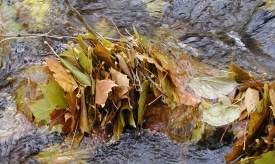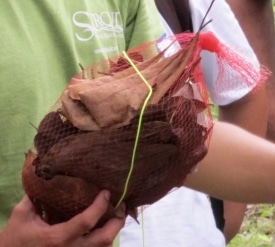The Leaf Pack Network® is designed to enhance understanding of stream ecosystems and to demonstrate the importance of streamside forests. Historically streams, and the life in those streams, evolved and developed under forested conditions. Researchers at Stroud Water Research Center have been studying the connection between streamside forests and stream ecosystems for decades.

Natural leaf pack
In the mid 1970s, the Stroud Center’s first director had an innovative idea of studying an entire watershed opposed to a section of stream as had been done in the past. Not only does a stream change physically as it flows downstream but it also changes biologically. The River Continuum Concept, developed by scientists from the Stroud Center and other institutions, was the first unified hypothesis about how streams and their watersheds work. A river is a single continuum that flows ceaselessly from its source to the sea. To understand it, you must know what is happening upstream and what is entering it from the watershed. Today, the River Continuum Concept is still the most widely cited study in the field of stream ecology.
Early research conducted for the River Continuum laid the foundation for more recent studies linking streamside forests and stream ecosystems. Since the mid-1980’s, it has been well known that streamside forests can function as filters for pollution. Ongoing research at the Center has determined that in addition to acting as buffers for pollution, streamside forests are an integral and essential part of the stream ecosystem that affect the physical, chemical and biological aspect of streams.

Artificial leaf pack
As part of their research, Stroud Center scientists have used leaf packs to better understand the stream ecosystem. In Costa Rica, for example, leaf packs have been used to study how tropical streams differ from temperate streams. Leaf packs in the Flint River in Georgia were used to assess effects of industrial effluents.
Conducting a leaf pack experiment by placing artificial leaf packs in the stream replicates the natural process of leaves forming packs in streams. Participants learn scientific principles, gain an understanding of how streams function as ecosystems, and are given an opportunity to communicate their data to the global community through the Leaf Pack Network.
Additional Readings
For more information about the leaf packs, the link between streamside forests and stream health, and the River Continuum, visit these pages on the Stroud Center website:


